IN THIS ISSUE
- Trapping tegus
- Experiences with fire
- The go-to grape for wildlife
- Looking for rare moths
- Endangered dropwort's big year
 USGS' Danny Haro sets a trap and shows a captured tegu (left/USGS; right/Georgia Southern University)
Danny Haro spends most days each week hunting for a needle in a haystack.
It’s just that this “needle” can grow to 4 feet long, sprint nearly 20 mph and gobble up everything from grasshoppers to young gopher tortoises.
Welcome to the front lines of the effort to find and remove Argentine black and white tegus in south Georgia's Tattnall and Toombs counties. …
Read about Haro’s role in rooting out these invasive lizards.
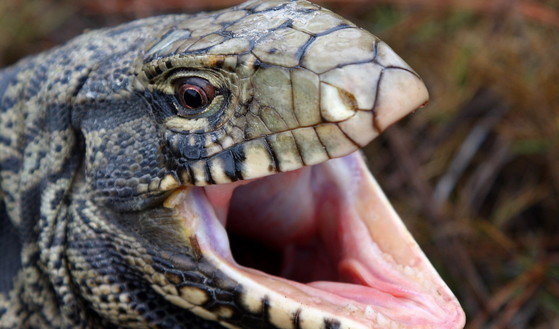 Argentine black and white tegu (Dustin Smith)
WHAT YOU CAN DO
- Report tegus in the wild, dead or alive. Take a photo (if possible), note the location and report the sighting at gainvasives.org/tegus. You can also contact DNR at (478) 994-1438 or gainvasives@dnr.ga.gov. Sightings help document occurrences and guide the effort by DNR, the U.S. Geological Survey and Georgia Southern University to trap tegus and study the population.
- Contact a wildlife trapper to remove tegus. A map of trappers by county is available at georgiawildlife.com, as is a list of rehabilitators. Note: Tegus in the wild can be trapped or killed according to animal cruelty and local ordinances, and with appropriate safety precautions. As a non-native invasive species, tegus are not protected by Georgia wildlife laws or regulations.
- Don’t leave pet food outside. Remove debris in your yard that tegus can use to hide or winter under.
- Be a responsible pet owner: Learn about an animal before you get it as a pet. And don’t let it loose (dontletitloose.com). It’s against the law in Georgia and can harm native wildlife.
- Learn more at georgiawildlife.com/tegus.
Top
 Flames creep across an Altamaha Grit outcrop at Broxton Rocks. (Ani Marty/DNR)
Prescribed fire is a topic that can vary from modelling smoke plumes to gauging how much controlled burns reduce the risk of wildfires.
But what is easy to lose in the science is the restorative power and even the beauty of prescribed fire.
For those perspectives, join two members of this year’s DNR southeast Georgia fire crew as they explore burning The Rocks and lighting up the night.
Top
 Muscadines on the vine (Terry W. Johnson)
By TERRY W. JOHNSON
We will never know how long people have relished the sweet taste of muscadines. Without question, admiration for the Grape of the South spans thousands of years, from Native Americans to the first Europeans in North America.
Yet it’s also clear that long before humans, wildlife were devouring the muscadine's rich-colored, thick-skinned fruits.
In light of that history, it is puzzling that when wildlife enthusiasts set out to turn their backyards into a haven for wildlife, they rarely consider this woody vine an important addition.
Here’s what they’re missing …
Read Terry’s column for insights into the attraction of these wild grapes.
Terry W. Johnson is a retired DNR program manager and executive director of TERN, the Wildlife Conservation Section’s friends group. Check out past columns, his Backyard Wildlife Connection blog and his book “A Journey of Discovery: Monroe County Outdoors.” Terry's columns are also featured on DNR’s blog, under the Conservation tab. Permission is required to reprint a column.
Top
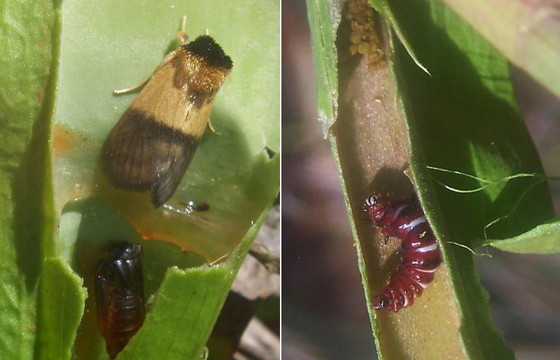 A pitcherplant mining moth and caterpillar (Hannah Nendick-Mason)
By ANNA YELLIN
On a warm night last August at a restored pitcherplant bog in south Georgia, more than 100 species of night-flying Lepidoptera visited our light. The moths sported various patterns and hues: grays, blues, greens, yellows and pinks. Some also were cryptic, perfectly resembling mosses, bark and leaves.
Yet although we recorded each species to create a site inventory, all were secondary to our goal. We were searching for Exyra and Papaipema genera moths, secretive species that depend on pitcherplants.
Moths, like other invertebrates in the order Lepidoptera (which includes moths, butterflies and skippers), are usually specialists that require certain host plants.
Pitcherplant moths – two of Exyra’s three species have been documented in Georgia – evolved to survive on their namesake plants. Not only do the caterpillars rely on this predatory plant as their larval food, they are uniquely equipped to avoid the plant’s dangers.
Unlike most insects, these caterpillars have claws that allow them to grip and move along the underside of the plant hoods, saving them from falling into the caustic pool of digestive enzymes in the tubular leaves of purple, red and hooded pitcherplants. These animals even use this unfriendly environment as shelter from inclement weather and potential predators at all stages of life, from minuscule egg to crawling caterpillar and fluttering moth.
Pitcherplants are also the required larval food for the pitcherplant borer moth, a Papaipema species. Instead of eating leaves, however, these caterpillars eat roots. Borers have been known to tunnel up to 1 foot into the root ball underneath a clump of pitcherplants, keeping the passage clear by pushing the frass out. Although the species has been found in coastal bogs in surrounding states, it has not been documented in Georgia.
That evening a year ago and on subsequent nights, we did not spot any of the pitcherplant or borer moths we sought. But we did see hundreds of other species, a sample of Georgia’s rich wildlife diversity.
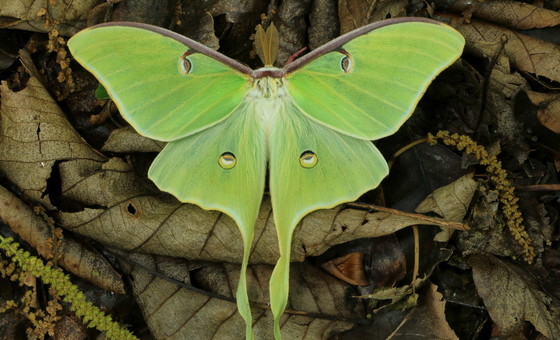 Luna moth in Chattooga County (Alan Cressler)
LOOKING INTO LEPIDOPTERA
Georgia’s moths and butterflies cover a wide spectrum in appearance and behavior. They also can be observed in a variety of places, from backyard gardens to front-porch lights. While summer is a prime time to see them, even the coldest months have occasional warm days and nights when these insects take flight.
Some species are endemic to specific areas. One example is the diurnal moth Ohoopee geometer (Fernaldella georgiana), a species of conservation concern in Georgia’s State Wildlife Action Plan. This moth was thought to occur only in Emanuel and Tattnall counties, with its larvae using the woody goldenrod found in the Ohoopee Dune ecosystem for nourishment.
But this year researchers James Adams and Lance Durden found Fernaldella georgiana at Alligator Creek Wildlife Management Area. Last year, caterpillars of the rare Okefenokee zale moth also were discovered at the Wheeler County WMA (“Parting Shots,” April 12, 2019). Adult Okefenokee zale moths have since been found there, as discussed in volume 42 of the Southern Lepidopterists’ News.
FOR MORE
Anna Yellin is a wildlife biologist with DNR’s Wildlife Conservation Section.
Top
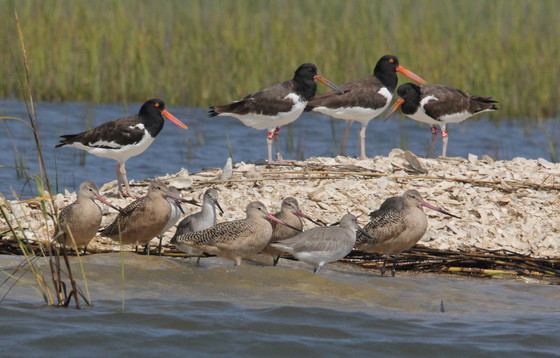 American oystercatchers, marbled godwits and willets on a shell rake (Tim Keyes/DNR)
The first round of fall International Shorebird Surveys along Georgia’s coast is underway. Data from the larger project led by the avian research organization Manomet help scientists chart population trends for more than 24 migrant species. DNR Wildlife Conservation Section biologists have also been monitoring nesting seabirds, shorebirds and wood storks, including 120 pairs of American oystercatchers coastwide, about 300 brown pelican nests on Little Egg Island Bar and 6,000-plus nests, mostly of royal terns, on Brunswick’s “Bird Island.”
The impact of Tropical Storm Isaias on sea turtle nests in Georgia proved relatively light. According to DNR Sea Turtle Program Coordinator Mark Dodd, 69 nests – about 2.5 percent of this year’s total – were lost to tidal surge, while most of the many nests washed over should still see hatching success rates of 50 percent of more. Follow nesting via the Georgia Sea Turtle Cooperative and seaturtle.org.
Signed into law Aug. 4, the Great American Outdoors Act includes full funding for the Land and Water Conservation Fund, which provides support for federal agencies and state grant programs including the Forest Legacy Program and the Cooperative Endangered Species Conservation Fund. Forest Legacy has provided millions for habitat conservation in Georgia, while the Cooperative Endangered Species Fund provides grants for the recovery of federally listed and candidate species.
Top
 Large-flowered skullcap browsed (left) and flowering (right) (Carlee Steppe/DNR)
A federally listed plant in northwest Georgia is taking a beating from white-tailed deer. Botanist Carlee Steppe’s analysis of large-flowered skullcap revealed that more than half the populations DNR monitors had been browsed by deer this year, up from about a third in previous years and suggesting that protections from hungry whitetails are needed to help this at-risk plant species recover.
The growing trade in saw palmetto berries, touted as a cure for varied health issues, has spurred moves in Georgia to regulate the harvest and sale of the berries, and protect the natural habitats the plants are part of. Learn more in this U.S. Fish and Wildlife Service blog post, as well as news coverage of the issue.
Want more outdoor recreational opportunities in Georgia? The statewide Plan for Outdoor Recreation (SCORP) is undergoing a five-year update and online public meetings are set for Aug. 20 and 27. A blueprint for maintaining and sustaining outdoor recreation resources statewide, SCORP 2022-2026 will keep Georgia eligible for Land and Water Conservation Fund support – adding to the $102 million in federal grants the state has received and leveraged with matching funds to invest $204 million-plus in city, county and state projects.
Top
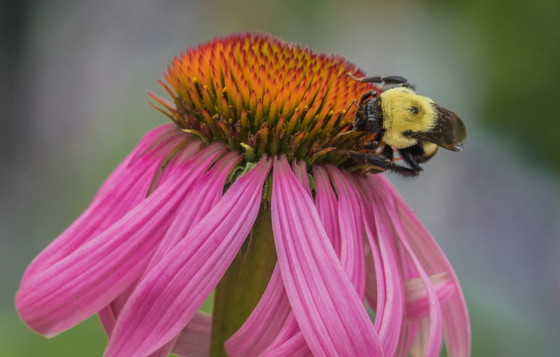 Bee on smooth purple coneflower (Natalie Birnbaum/Georgia Nature Photographers Association)
The Great Georgia Pollinator Census is only days away. This annual public count of pollinators from bumblebees to butterflies statewide is set for Aug. 21-22 and coordinated by the University of Georgia Extension.
Atlanta Audubon is now Georgia Audubon, underscoring the group’s new statewide emphasis and partnerships with other in-state Audubon chapters to expand programs, engage more people and enhance bird conservation. “As Georgia Audubon,” said Executive Director Jared Teutsch, “we will seek to adopt a broader focus to connect birds and people across the state.”
Squirrel season's opening Saturday kicked off the hunting year in Georgia. Hunting regulations are available at license vendors, online and on the Go Outdoors Georgia app. For anyone new to hunting, whether squirrels, deer, rabbits, dove or turkeys, DNR Hunt and Learn programs are a solid starting point.
Top
 DNR botanist Lisa Kruse beside yellow flytrap pitcherplants at the south Georgia bog (Carlee Steppe/DNR)
Georgia Power Co.'s vegetation management crew learned more about Coastal Plain herbaceous bogs during a workday with DNR at a bog complex near Statesboro. The site, the state’s only known home for Coastal Plain purple pitcherplant, is part of a powerline right of way that Georgia Power maintains.
Charlie Elliott Wildlife Center’s annual Conserve Animals in Nature camp – dubbed iCAN –schooled youth ages 10-13 in citizen science opportunities and studying wildlife last month. Campers at the Mansfield center learned how to use apps such as iNaturalist, built a bird sanctuary and made casts of animal tracks.
Names in the news: Elachee Nature Science Center President Andrea Timpone has received this year's Nature Leadership Award for her work at the Gainesville center. The national honor is announced annually by the Association of Nature Center Administrators. DNR senior wildlife biologist Shan Cammack gave a presentation as part of a North Carolina State University Extension Forestry webinar on using virtual programs to cover prescribed fire topics. The online audience numbered more than 280.
WHAT YOU MISSED ...
In the previous Georgia Wild:
- Conserving a living prairie relic
- Fewer hummingbirds? July will help tell
- Fungus behind bat-killing disease moves south
- A cottonmouth encounter and crow vs. osprey
Top
"DNR: Fungus deadly to bats moves south," WALB-TV (Ch. 10, Albany). Also: Athens Banner-Herald, All on Georgia.
"Ceylon newest WMA," Savannah Morning News. Also: "Surveying gopher tortoises at Ceylon."
"Spotting right whales from space could help save them," Canadian Broadcasting Corp.
"Why Georgia is regulating saw palmetto berry harvests," WABE-FM (90.1, Atlanta)
"Eagle Scout project replaces boardwalk at Georgia Wildlife Federation," The Citizens (Rockdale, Newton counties)
"Grants will help protect habitat in Georgia, other states," The Albany Herald
(+video) "What the bear roaming Marietta looked like," WXIA-TV (Ch. 11, Atlanta)
(+video) "Why bears are hugging, licking trees in Georgia," The Charlotte (N.C.) Observer
"Maine lobster fishery loses certification as sustainable," SouthCoastToday (New Bedford, Mass.)
"Partners restore habitat to benefit gopher tortoise," Fish and Wildlife Service blog
"Help stop the spread of tegus in Georgia," Monroe County Reporter
"Florida commission approves draft rules for high-risk invasive reptiles," EIN. Also: "Reptile breeders sue state," Orlando (Fla.) Weekly
"5,000 Burmese pythons removed from Everglades," Fox News
(+audio) "Whales get a break as pandemic creates quieter oceans," NPR
"Eagle sends state's drone to bottom of Lake Michigan," mlive.com
Top
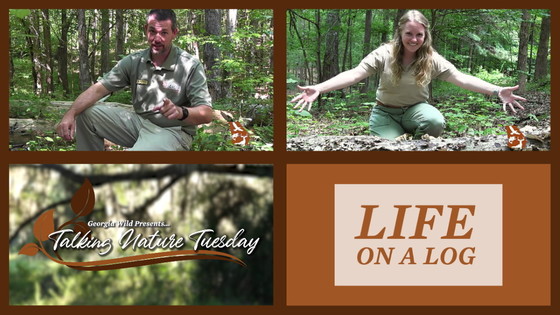 "Talking Nature Tuesday: life on a log," DNR
(audio) "Scientists are burning the woods," featuring DNR's Nathan Klaus and Dr. Joyce Klaus, The Native Plant Podcast
"Wear it: boating safety" (survivor recounts accident), National Safe Boating Council
"Take the family bass fishing," DNR
Top
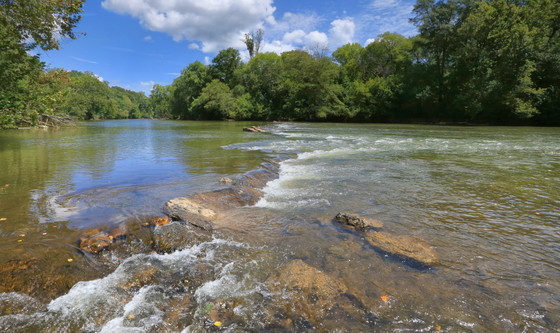 Lower Etowah River in Bartow County (Alan Cressler)
Free on-line opportunities involving wildlife conservation.
Top
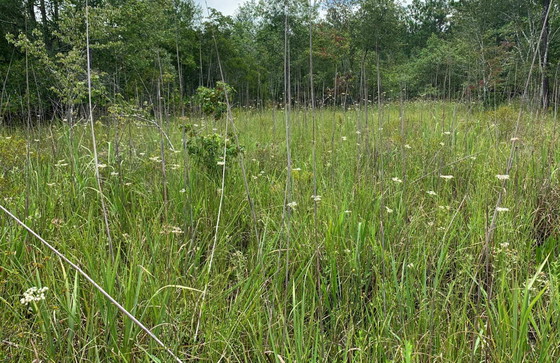 Canby’s dropwort blooms across a conservation site in Vienna; below, dropwort flowers. (Carlee Steppe/DNR)
Endangered Canby’s dropwort is having a breakout summer. DNR’s botany team of Lisa Kruse, Morgan Bettcher and Carlee Steppe found about 200 plants at Oakbin Pond, the first occurrence of this rare plant at The Nature Conservancy preserve near Unadilla in 12 years. Oakbin Pond once had one of the state’s largest Canby’s dropwort populations and has been the focus of habitat restoration led by the U.S. Department of Agriculture’s Natural Resources Conservation Service. Meanwhile, another 100 plants were discovered at a new site in Lee County, checked at the landowner’s invitation. And thousands of the slender, perennial herb were found blooming across the wet meadow at the Woodward Canby’s Dropwort Preserve (pictured), a private property in Vienna. Water quality and plant populations are monitored at each site. Canby’s dropwort (Oxypolis canbyi) favors wetlands such as cypress ponds and wet savannas with acidic soils, fluctuating water levels and little to no tree canopy (“Restoration pegs rare plant,” December 2011).

CREDITS
Masthead: prescribed fire at night (Garrett Anderson/DNR)
Top
|